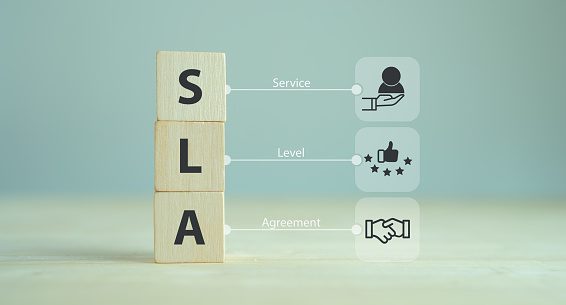What is an SLA? And when is the right time to implement it
Expect the unexpected. Plan for the worst. Profit from what is happening.
While your company takes great care to ensure that every customer transaction goes as smoothly as possible, unforeseen complications can arise. If this happens, even the simplest of actions can quickly turn into a nightmare.
Fortunately, there is a way to ensure that virtually every customer or project crisis is resolved immediately: having a Service Level Agreement (SLA).
SLA is another phrase you often hear in business, however, what exactly does it mean? Why might your company need it? What exactly do they entail?
SLA is short for Service-Level Agreement. These contracts are common in business and are especially popular in the IT sector, as tech companies often use each other’s services. These can be Internet Service Providers, Cloud Computing Specialists, Enterprise Transformation Consultants, or Managed Print Solutions.
SLAs are typically used to manage services provided between an organization and an external provider, but they can also exist between departments within the same large organization.
In this article, we’ll discuss everything about SLAs, including when is the best time to implement them.
What is an SLA?
A service level agreement (or SLA) is a clause in a contract that specifies the services that the service provider will offer, as well as the required level of quality for those solutions. The SLA is usually part of an outsourcing or managed service contract, although it can also be used in property management contracts and other contractual relations.
What is the difference between SLA and contract? The main difference is that contracts can be closed without specifying any service levels. While most organizations are unlikely to interact with service providers on a regular basis to celebrate quality under a normal contract, a service level agreement is about negotiation, regular evaluation, strong communication, and room for change.
Here SLA Slack example which promises almost 100% uptime to its customers.
However, the SLA may or may not be part of an informal or legal contract. As a result, although a SLA may be contained in an agreement, the contract is not always a SLA. Many firms choose to have SLAs that are not part of the agreement itself because it gives more flexibility in the amendment.
What is included in the SLA?
A well-written and thoughtful SLA should include the following components.
Summary of the Agreement
Your SLA should begin with a summary of the agreement. What help did you promise to give to the other side? Describe the service, who will receive it, and how the effectiveness of the service will be measured.
Goals for both sides
The goals specified in external service level agreements between the company and its customers are, in fact, the goals of the client. If this is your plan, work with your client to match their requirements with your product’s capabilities and develop a measurable goal that your firm can achieve for the client on a regular basis.
Is this an internal service level agreement between your sales and marketing departments? The goals of both groups must be defined in this area of agreement, and to ensure that when marketing achieves its goal, sales can achieve its own.
Requirements of both parties
SLAs should indicate what each stakeholder needs to achieve their goals. Keep in mind that user requirements may go beyond the “product” in the contracts that serve them. They may need something more to achieve their goals, such as weekly consultations, documentation, and technical support from you.
SLAs between marketing and sales should indicate what they want from the other department to help them achieve their goals. Marketing, for example, may want to receive weekly sales funnel status updates so that marketers can adjust their lead generation initiatives accordingly.
Points of contact
Who is responsible for ensuring that the goals of each party are achieved? In this part of your SLA, define which team does what and who communicates with whom. Is the service being used by a different employee than the person reporting weekly performance? Be clear about who is and is not participating in the SLA.
Plan in case goals are not achieved
You may not want to think about it, but there should be clear consequences when the SLA goal is not met. However, don’t panic; these consequences will not necessarily be catastrophic for your firm. Include a method of compensating the end user of the service if the service does not achieve the agreed goals. According to PandaDoc, this compensation can take the form of “service credits” in external SLAs.
For sales and marketing SLAs, partner with your sales team for strategy development to compensate for lost profits as a result of non-fulfillment of the sales quota. You can implement a strike system that makes certain employees, both in marketing and sales, responsible for identifying and correcting performance problems.
Cancellation conditions
When will your SLA be withdrawn? Whether your agreement covers one client or two departments within an organization, you tend to remove an SLA when it just doesn’t work. Perhaps your goals have not been met in the previous three months, or the current agreement simply has not received approval from all parties involved.
Create clear grounds for canceling the current SLA in favor of a possibly higher SLA.
Why does your business need an SLA?
Check out this article for more information on best SLA practices. SLAs are essential if your company frequently outsources tasks to third party vendors (or to different parts of your organization) as they protect the interests of both parties by defining the expected quality of service and criteria for performance monitoring from the very beginning. Penalties may be imposed if the work is not completed within the agreed time frame or if the contract is breached.
While most vendors and organizations have basic SLAs, specific terms are usually negotiated between the client and the service provider before they are evaluated and approved by legal teams.
The SLA is necessary because without it, either party can easily disclaim liability if their relationship runs into difficulties. It can also provide a firm with a lot of data in terms of key performance indicators. It also makes it easy for a corporation to identify areas where it can improve customer service, even if customer support is a clear priority.
The SLA creates a quantitative and accurate performance baseline for employees. Finally, the SLA defines penalties for non-compliance, demonstrating the organization’s commitment to achieving its goals, and also communicates to the client when there are penalties.
The undoubted importance of SLA
SLA is an important component any contract, and in the long run it will be beneficial if it is carefully thought out and formalized from the very beginning of the relationship. He protects both sides and, in case of conflict, determines solutions to avoid misunderstandings. This can save both the customer and the supplier a lot of time and money.
SLAs should ideally be related to the technical or commercial objectives of the assignment. Irregularity can adversely affect the price of the transaction, the efficiency of service delivery and customer satisfaction.
Author biography- Tuba Sarosh
Tuba Sarosh is a results-driven SEO content writer and editor who helps businesses convert their readers into customers. She writes about trends, tips, how-to’s and other cool things that help companies serve their customers better. When she’s not writing, she’s either reading a good book or experimenting with recipes.







